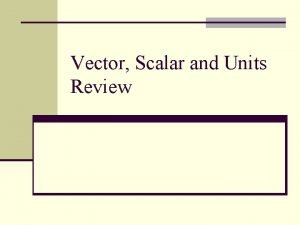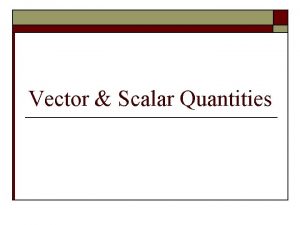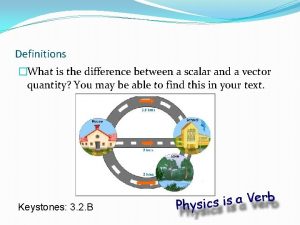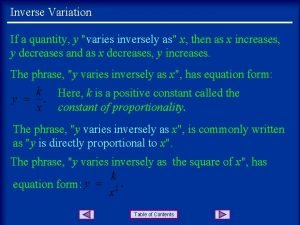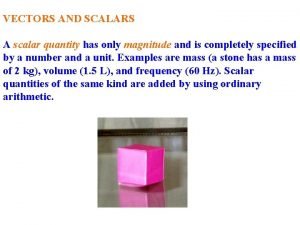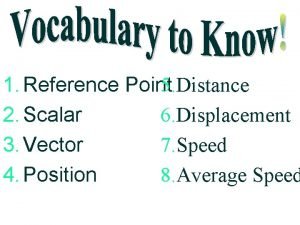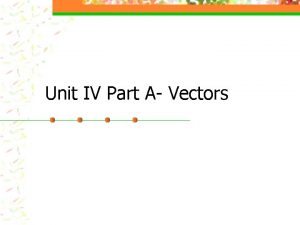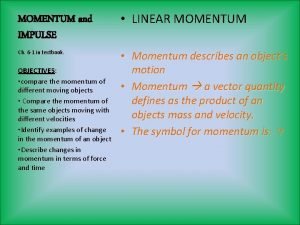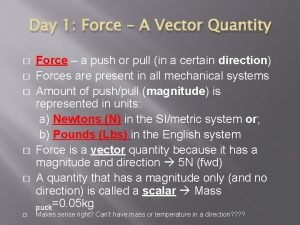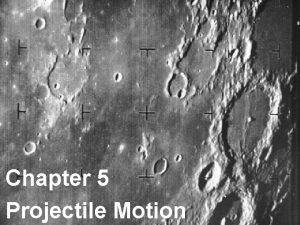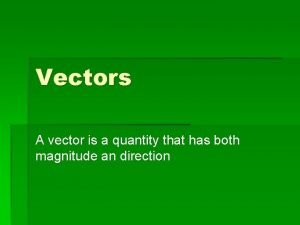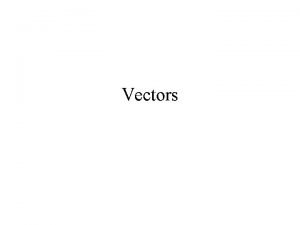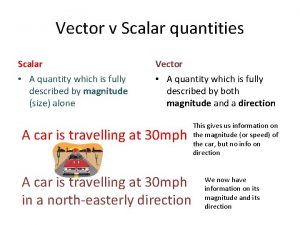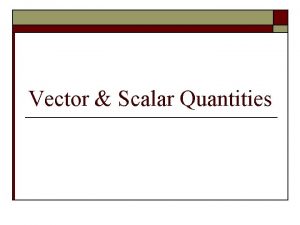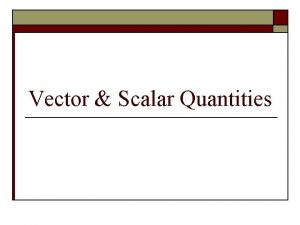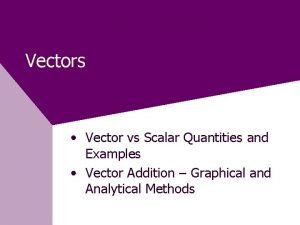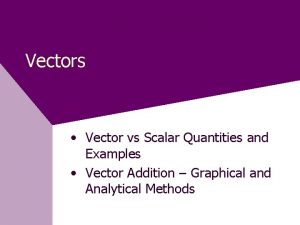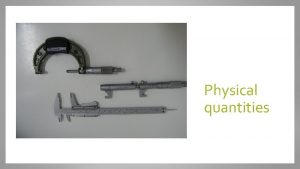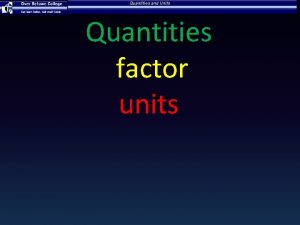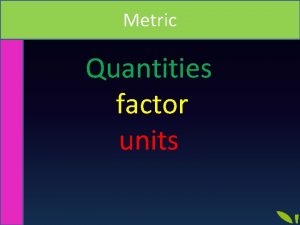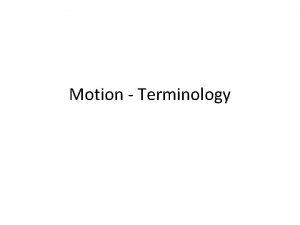Vector Scalar Quantities Characteristics of a Scalar Quantity
























- Slides: 24

Vector & Scalar Quantities

Characteristics of a Scalar Quantity o o Only has magnitude Requires 2 things: 1. A value 2. Appropriate units Ex. Mass: 5 kg Temp: 21° C Speed: 65 mph

Characteristics of a Vector Quantity o o Has magnitude & direction Requires 3 things: 1. A value 2. Appropriate units 3. A direction! Ex. Acceleration: 9. 8 m/s 2 down Velocity: 25 mph West

More about Vectors o A vector is represented on paper by an arrow 1. the length represents magnitude 2. the arrow faces the direction of motion 3. a vector can be “picked up” and moved on the paper as long as the length and direction its pointing does not change

Graphical Representation of a Vector The goal is to draw a mini version of the vectors to give you an accurate picture of the magnitude and direction. To do so, you must: 1. Pick a scale to represent the vectors. Make it simple yet appropriate. 2. Draw the tip of the vector as an arrow pointing in the appropriate direction. 3. Use a ruler & protractor to draw arrows for accuracy. The angle is always measured from the horizontal or vertical.

Understanding Vector Directions To accurately draw a given vector, start at the second direction and move the given degrees to the first direction. N W 30° N of E E Start on the East origin and turn 30° to the North S

Graphical Representation Practice o 5. 0 m/s East (suggested scale: 1 cm = 1 m/s) o 300 Newtons 60° South of East (suggested scale: 1 cm = 100 N) o 0. 40 m 25° East of North (suggested scale: 5 cm = 0. 1 m)

Graphical Addition of Vectors 1. 2. 3. 4. Tip-To-Tail Method Pick appropriate scale, write it down. Use a ruler & protractor, draw 1 st vector to scale in appropriate direction, label. Start at tip of 1 st vector, draw 2 nd vector to scale, label. Connect the vectors starting at the tail end of the 1 st and ending with the tip of the last vector. This = sum of the original vectors, its called the resultant vector.

Graphical Addition of Vectors (cont. ) Tip-To-Tail Method 5. Measure the magnitude of R. V. with a ruler. Use your scale and convert this length to its actual amt. and record with units. 6. Measure the direction of R. V. with a protractor and add this value along with the direction after the magnitude.

Graphical Addition of Vectors (cont. ) 5 Km Scale: 1 Km = 1 cm 3 Km Resultant Vector (red) = 6 cm, therefore its 6 km.

Vector Addition Example #1 o Use a graphical representation to solve the following: A hiker walks 1 km west, then 2 km south, then 3 km west. What is the sum of his distance traveled using a graphical representation?

Vector Addition Example #1 (cont. ) Answer = ? ? ? ?

Vector Addition Example #2 o Use a graphical representation to solve the following: Another hiker walks 2 km south and 4 km west. What is the sum of her distance traveled using a graphical representation? How does it compare to hiker #1?

Vector Addition Example #2 (cont. ) Answer = ? ? ? ?

Mathematical Addition of Vectors o Vectors in the same direction: Add the 2 magnitudes, keep the direction the same. Ex. + = 3 m E 1 m E 4 m E

Mathematical Addition of Vectors o Vectors in opposite directions Subtract the 2 magnitudes, direction is the same as the greater vector. Ex. 4 m S + 2 m N = 2 m S

Mathematical Addition of Vectors o Vectors that meet at 90° Resultant vector will be hypotenuse of a right triangle. Use trig functions and Pythagorean Theorem.

Mathematical Subtraction of Vectors Subtraction of vectors is actually the addition of a negative vector. o The negative of a vector has the same magnitude, but in the 180° opposite direction. Ex. 8. 0 N due East = 8. 0 N due West 3. 0 m/s 20° S of E = 3. 0 m/s 20° N of W o

Subtraction of Vectors (cont. ) o o o Subtraction used when trying to find a change in a quantity. Equations to remember: ∆d = df – di or ∆v = vf – vi Therefore, you add the second vector to the opposite of the first vector.

Subtraction of Vectors (cont. ) o Ex. = Vector #1: 5 km East Vector #2: 4 km North 5 km W (-v 1) 4 km N (v 2) I know it seems silly, but trust me on this one!!!

Component Method of Vector Addition o Treat each vector separately: 1. To find the “X” component, you must: Ax = Acos Θ 2. To find the “Y” component, you must: Ay = Asin Θ 3. Repeat steps 2 & 3 for all vectors

Component Method (cont. ) 4. Add all the “X” components (Rx) 5. Add all the “Y” components (Ry) 6. The magnitude of the Resultant Vector is found by using Rx, Ry & the Pythagorean Theorem: RV 2 = Rx 2 + Ry 2 7. To find direction: Tan Θ = Ry / Rx

Component Method (cont. ) Ex. #1 V 1 = 2 m/s 30° N of E V 2 = 3 m/s 40° N of W (this is easy!) Find: Magnitude & Direction Magnitude = 2. 96 m/s Direction = 78° N of W

Component Method (cont. ) Ex. #2 F 1 = 37 N 54° N of E F 2 = 50 N 18° N of W F 3 = 67 N 4° W of S (whoa, this is not so easy!) Find: Magnitude & Direction Magnitude =37. 3 N Direction = 35° S of W
 Similarities between scalar and vector quantities
Similarities between scalar and vector quantities Vector quantity
Vector quantity A quantity that has magnitude or size
A quantity that has magnitude or size Scalar quantity and vector quantity
Scalar quantity and vector quantity Scalar units
Scalar units Characteristics of vector quantity
Characteristics of vector quantity A vector quantity has ______ and direction.
A vector quantity has ______ and direction. Centripetal acceleration
Centripetal acceleration Scalar and vector quantity difference
Scalar and vector quantity difference Relation between linear and angular quantities
Relation between linear and angular quantities Vary inversely
Vary inversely Scalar quantity has
Scalar quantity has Distance is a ____ quantity
Distance is a ____ quantity Measured quantity
Measured quantity Which of the following is a pair of vector quantities
Which of the following is a pair of vector quantities 30 examples of vector quantities
30 examples of vector quantities Momentum is a vector quantity
Momentum is a vector quantity Which has a greater momentum a truck with a mass of 2250 kg
Which has a greater momentum a truck with a mass of 2250 kg A force is a vector quantity because it has both
A force is a vector quantity because it has both Aristotle view of projectile motion
Aristotle view of projectile motion Acceleration vector quantity
Acceleration vector quantity A vector is a quantity that has
A vector is a quantity that has Adding multiple vectors
Adding multiple vectors Vector in physics
Vector in physics Vector quantity
Vector quantity




